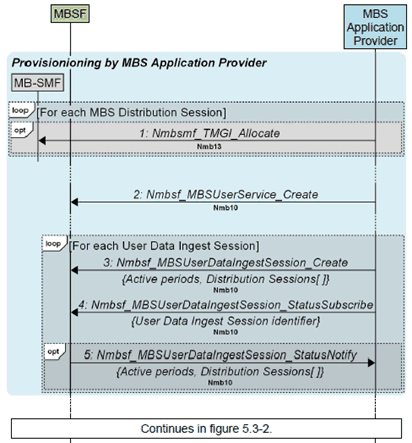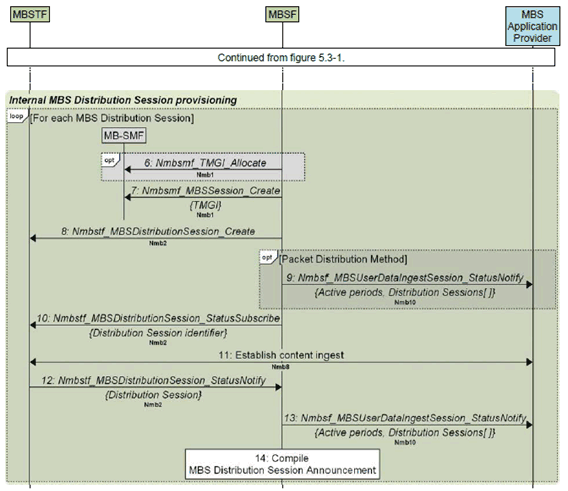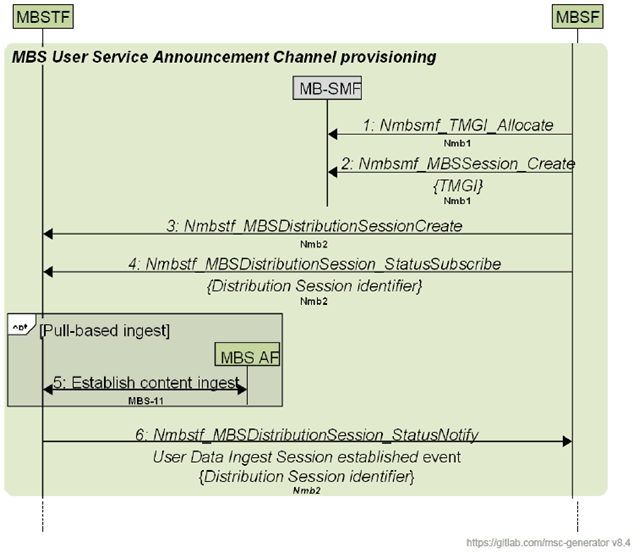Content for TS 26.502 Word version: 18.1.0
5.3 Procedures for User Service provisioning
5.3A Procedures for User Service Announcement Channel provisioning
...
...
5.3 Procedures for User Service provisioning p. 41
The procedure begins with the MBS Application Provider provisioning an MBS User Service and, within its scope, a set of MBS User Data Ingest Sessions, as shown in Figure 5.3-1 and Figure 5.3-2 below.

Figure 5.3-1: Call flow for MBS User Service provisioning by MBS Application Provider
(⇒ copy of original 3GPP image)
(⇒ copy of original 3GPP image)
First, the MBS Application Provider provisions a new MBS User Service Session in the MBS System:
Step 1.
Immediately, or at some later time, the MBS Application Provider creates at least one MBS User Data Ingest Session (as defined in clause 4.5.5) within the scope of the MBS User Service created in step 2 above:
To support Use Cases (e.g. Group Communication) where there is a requirement for TMGI allocation to be managed outside the MBS System, the MBS Application Provider may pre-allocate a TMGI for some or all of the MBS Distribution Sessions declared in step 3 below by invoking the Nmbsmf_TMGI_Allocate service operation on the MB-SMF at reference point Nmb13 (or N33+N29mb, if invoked via the NEF), as specified in clause 9.1.2.2 of TS 23.247.
Step 2.
The MBS Application Provider invokes the Nmbsf_MBSUserService_Create service operation at reference point Nmb10 (or N33+Nmb5 if invoking via the NEF) to create a new MBS User Service, as defined in clause 4.5.3.
Step 3.
Shortly before a provisioned MBS User Data Ingest session is scheduled to become active (see clause 4.5.5), or immediately if no schedule of active periods is provisioned, the MBSF establishes in the MBSTF all MBS Distribution Sessions comprising that MBS User Data Ingest Session as shown in Figure 5.3-2 below.
The MBS Application Provider creates an MBS User Data Ingest Session by invoking the Nmbsf_MBSUserDataIngestSession_Create service operation at reference point Nmb10 (or N33+Nmb5, if invoked via the NEF).
The MBS User Data Ingest Session optionally includes a schedule of start and end times referred to as active periods.
The MBS User Data Ingest Session comprises the details of one or more MBS Distribution Session(s), as defined in clause 4.5.6. Each such MBS Distribution Session fully specifies one of the distribution methods defined in clause 6 and may optionally nominate a TMGI to be used if one was pre-allocated in step 1 above.
Step 4.
The MBS Application Provider subscribes to status events from the MBSF relating to the MBS User Data Ingest Session just created by invoking Nmbsf_MBSUserDataIngestSession_StatusSubscribe service operation at reference point Nmb10 (or N33+Nmb5, if invoked via the NEF).
Step 5.
Void.

For each such MBS Distribution Session of a parent MBS User Data Ingest session:
Step 6.
The following steps do not need to wait for the completion of step 8:
If no MBS Session ID was nominated by the MBS Application Provider in step 1 above, the MBSF may allocate a TMGI for it at this point by invoking the Nmbsmf_TMGI_Allocate service operation on the MB-SMF at reference point Nmb1, as specified in clause 9.1.2.2 of TS 23.247.
Step 7.
The MBSF creates an MBS Session to reserve resources in the MBS System for the MBS Distribution Session by invoking the Nmbsmf_MBSSession_Create service operation on the MB-SMF at reference point Nmb1, as specified in clause 9.1.3.6 of TS 23.247). The MBS Session ID provided for the MBS Distribution Session in step 1 or reserved in step 6 above is provided as an input parameter, if available. If needed, the MB-SMF allocates a TMGI as a side-effect of this operation. The MBSF determines the other input parameters as specified in clause 4.5.9.
Step 8.
For MBS Distribution Sessions of Service type broadcast, the MB-SMF notifies the MBSF upon successful establishment of the corresponding MBS Session(s).
Step 9.
Once it is satisfied that the Broadcast MBS Session has been successfully established, the MBSF notifies the MBS Application Provider about the successful establishment of the Broadcast MBS Session(s) corresponding to the MBS Distribution Session using one or more Session started events.
Step 10.
When the MBSF has completed its attempt to configure all MBS Distribution Sessions required by the parent MBS User Data Ingest Session:
The MBSF creates the MBS Distribution Session in the MBSTF by invoking the Nmbstf_MBSDistributionSession_Create service operation at reference point Nmb2. This is a mirror of the entity in the MBSF (see clause 4.5.6).
Step 11.
- In the case of the Object Distribution Method with push-based Object acquisition method, the response includes additional content ingest parameters chosen by the MBSTF for this MBS Distribution Session (see Object ingest base URL in Table 4.5.6-2).
- In the case of the Packet Distribution Method, the response includes additional content ingest parameters chosen by the MBSTF for this MBS Distribution Session (see MBSTF ingest endpoint addresses in Table 4.5.6-3).
The MBSF invokes the Nmbsf_MBSUserDataIngestSession_StatusNotify service operation at reference point Nmb10 (or Nmb5+N33, if invoked via the NEF) to inform the MBS Application Provider of the content ingest parameters that have been chosen for this MBS Distribution Session using the Distribution Session starting event (see MBSTF ingest endpoint addresses in Table 4.5.6-3).
Step 12.
The MBSF subscribes to status events from the MBSTF relating to the MBS Distribution Session just created by invoking the Nmbstf_MBSDistributionSessionStatusSubscribe service operation at reference point Nmb2.
Step 13.
In the case of the Packet Distribution Method and pull-based content ingest using the Object Distribution Method, the MBSTF attempts to establish content ingest from the MBS Application Provider at reference point Nmb8 according to the ingest parameters and distribution method provisioned for the MBS Distribution Session in question (see Table 4.5.6-1).
On success, the state of the MBS Distribution Session in the MBSTF becomes ESTABLISHED; on failure, it remains INACTIVE (see step 2 in clause 4.6.1).
Step 14.
The MBSTF invokes the Nmbstf_MBSDistributionSession_StatusNotify callback service operation at reference point Nmb2 to inform the MBSF of the (un)successful establishment of content ingest using the Distribution Session established event.
On success, the state of the MBS Distribution Session in the MBSF becomes ESTABLISHED; on failure, it remains INACTIVE (see step 2 in clause 4.6.1).
Step 15.
The MBSF invokes the Nmbsf_MBSUserDataIngestSession_StatusNotify callback service operation at reference point Nmb10 (or Nmb5+N33, if invoked via the NEF) to inform the MBS Application Provider of the (un)successful establishment of content ingest for the MBS Distribution Session in the context of its parent MBS User Data Ingest Session using either the Distribution Session established event or Distribution Session establishment failure event, as appropriate.
Step 16.
If content ingest was established successfully in step 11 above, the MBSF compiles the metadata relating to this MBS Distribution Session into an MBS Distribution Session Announcement, as defined in clause 4.5.8.
Step 17.
The MBSF invokes the Nmbsf_MBSUserDataIngestSession_StatusNotify callback service operation at reference point Nmb10 (or Nmb5+N33, if invoked via the NEF) to inform the MBS Application Provider of the (un)successful establishment of all MBS Distribution Sessions of the parent MBS User Data Ingest Session using either the User Data Ingest Session established event or User data ingest failure event, as appropriate.
5.3A Procedures for User Service Announcement Channel provisioning p. 44
The procedures depicted in Figure 5.3A-1 are optionally followed in deployments where an MBS User Service Announcement Channel is provided at reference point MBS-4-MC as part of the MBS System. Where deployed, the MBS User Service Announcement Channel shall be provisioned as an MBS Distribution Session using the OBJECT_CAROUSEL operating mode of the Object Distribution Method.

Figure 5.3A-1: Procedures for User Service Announcement provisioning
(⇒ copy of original 3GPP image)
(⇒ copy of original 3GPP image)
The steps are as follows:
Step 1.
As a consequence of this provisioning, the MBSTF now begins polling for updates to the object manifest (see step 2B in clause 5.4) if pull-based object acquisition was provisioned in step 3. If push-based object acquisition was specified, the MBSTF instead waits for an object manifest with the provisioned URL path to be published to it.
The MBSF allocates a TMGI for the MBS User Service Announcement Channel by invoking the Nmbsmf_TMGI_Allocate service operation on the MB SMF at reference point Nmb1, as specified in clause 9.1.2.2 of TS 23.247.
Step 2.
The MBSF creates an MBS Session to reserve resources in the MBS System for the MBS User Service Announcement Channel by invoking the Nmbsmf_MBSSession_Create service operation on the MB-SMF at reference point Nmb1, as specified in clause 9.1.3.6 of TS 23.247). The MBS Session ID reserved in the previous step is provided as an input parameter. The MBSF determines the other input parameters as specified in clause 4.5.9.
Step 3.
The MBSF creates the MBS Distribution Session in the MBSTF by invoking the Nmbstf_MBSDistributionSession_Create service operation at reference point Nmb2. This is a mirror of the entity in the MBSF (see clause 4.5.6). The Object Distribution Method and carousel operating mode are indicated. Either push- or pull-based object acquisition may be provisioned. A single object acquisition identifier is provisioned. In the case of pull-based object acquisition, this is the path, relative to the Object ingest base URL, of an object manifest resource available for retrieval from the MBS AF. In the case of push-based object acquisition it is a URL path, relative to the Object ingest base URL, to which the object manifest will be published by the MBSF.
Step 4.
The MBSF subscribes to status events from the MBSTF relating to the MBS Distribution Session just created by invoking the Nmbstf_MBSDistributionSessionStatusSubscribe service operation at reference point Nmb2.
Step 5.
If pull-based ingest was provisioned in step 3, the MBSTF attempts to establish content ingest from the MBS AF at reference point MBS-11 according to the ingest parameters and distribution method provisioned in step 3 (see Table 4.5.6-1 and Table 4.5.6-2).
Step 6.
The MBSTF invokes the Nmbstf_MBSDistributionSession_StatusNotify callback service operation at reference point Nmb2 using the Distribution Session established event to inform the MBSF of the (un)successful establishment of content ingest with the MBS AF.